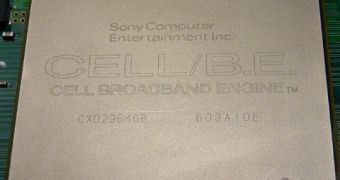Sure thing, this year's International Solid-State Circuits Conference brought a multitude of novelties in the processor industry. We have seen Intel's two billion transistors behemoth, as well as Sun's 16-core server chip, and there are many yet to come. The latest surprise in terms of processors comes from IBM, who announced a 45-nanometer version of its popular Cell BE chip.
The Cell processor powers Sony's Playstation 3 gaming console and is built on IBM's 65-nanometer SOI process. However, IBM decided that it's high time for the chip to became more energy-efficient and more powerful than it currently is. Needless to say that the Cell BE is world's most powerful CPU at this time.
According to IBM's datasheets, the updated 45-nanometer Hi-K Cell BE chip will use about 40 percent less power than the 65-nanometer version. At the same time, the 45-nanometer process will allow the company shrink its die area up to 34 percent, as at this point transistors are much smaller than in the 65-nanometer scale.
The transition will allow hardware designers cut down costs of active cooling solutions as well as smaller and cheaper chip package. Given the fact that the chip will cost less and the lack of fans will also cut down a few bucks, you should expect more powerful and cheaper gaming consoles. However, this is unlikely to happen if Sony decides that it's time to boost its profits all of a sudden.
The Cell processor was presented as ready to go beyond the gaming universe in the PlayStation consoles. The processor may get universal adoption in more devices, but Sony will still be the number one customer for the Cell chip. "To guarantee the proper operation of existing gaming software, the exact cycle-by-cycle machine behavior, including operating frequency, must be preserved," reads the IBM paper.
When preparing the 45-nanometer version of the chip, IBM especially thought of Sony. The chip manufacturer could improve the processor's performance as well, but it decided to keep the actual technical specifications in a smaller package. These specifications date back in time: The 45-nanometer chip inherited its functionality from the 65-nanometer unit, who had also inherited them from the 90-nanometer unit.
All the process is aimed at delivering cheaper and more affordable PlayStation 3 gaming consoles, but it will also allow IBM to use super-efficient Cell BE processor for its supercomputing division.

 14 DAY TRIAL //
14 DAY TRIAL //